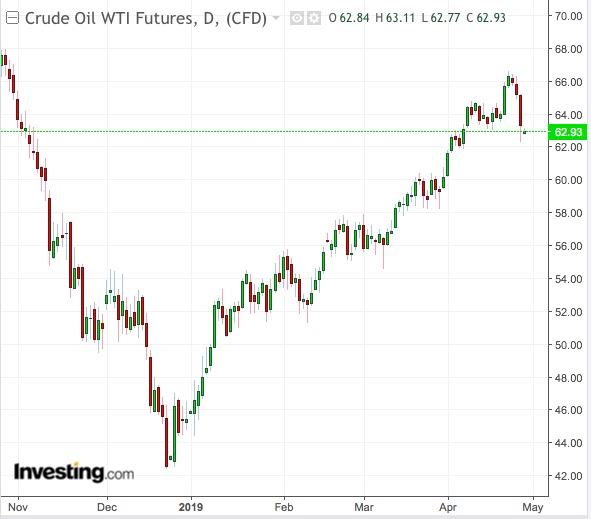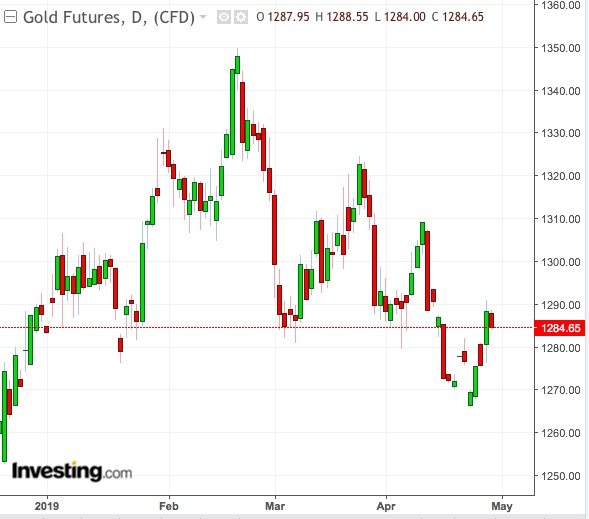A week ago, this column suggested that Donald Trump would tap into his creativity in disrupting oil prices if Saudi Arabia didn’t raise production quickly to reciprocate his gesture of trying to bring Iranian crude exports to zero. On Friday, the U.S. president made good on our suggestion, feeding the market with a ludicrous tale to short-circuit the rally in oil.
Trump announced that he had “called” the Organization of Petroleum Exporting Countries to lower domestic gasoline prices and that pump prices were already falling. Neither statement was true, for obvious reasons. U.S. pump prices are determined as much by fuel demand, stockpiles and refining margins as the crude provided by both OPEC and local drillers.
And when Trump spoke on Friday morning, U.S. oil company AAA was still reporting a 27% hike year-to-date hike in pump prices. Also, before the end of the session, OPEC's Secretary General Mohammed Barkindo denied having spoken with the U.S. president.
Yet, Trump's story brought the runaway rally in oil to a screeching halt, handing bulls an unexpected 3% loss on the day. The declines continued in Monday’s Asian trading, with ANZ bank widening its interpretation of Trump’s words as to meaning “he had spoken with Saudi Arabia about reducing the impact of lower Iranian oil exports by increasing flows elsewhere.”

Presidents seldom have it this good from energy bankers. It’s also unclear how many traders genuinely believed Trump on Friday, and how many just needed an excuse to cash out of a monstrous seven-week rally. While off from its near six-month high of $65 per barrel from last week, U.S. West Texas Intermediate crude is still up 39% on the year. Brent, the London-traded global benchmark for oil, shows an annual gain of 33% despite sliding from last week’s peak of $75—a high last matched in October.
Fear Of More Trump Surprises
For what it’s worth, the fear of Trump doing the unexpected—like denying buyers of Iranian oil anymore sanction waivers last week—seems as valid in the market as the fear that prices can only go higher from the apparent reluctance of OPEC lynchpin Saudi Arabia to preemptively raise production to replace lost Iranian barrels.
Oil bulls might have good reason to fear Trump: It was the president who was responsible for lifting WTI to $65 and Brent to $75 with his renewed pledge to wipe Iran off the market. No one has forgotten how Trump engineered the 40% oil price crash in the fourth quarter of 2018 by tricking the Saudis and rest of OPEC into raising production first, then handing out sanction waivers like candy to buyers of Iranian crude.
Notwithstanding separate U.S. sanctions on Venezuelan oil and other output outages in Libya and Angola, some think the market is overbought and ripe for correction. Hence, the worry over what “bullets” Trump may have left to shoot down the crude rally, since high gas prices could be a big negative for him between now and the pick-up of his reelection campaign in 2020.
The Saudis Could Quietly Help Out The U.S. President Too
And while the Saudis have publicly stiffed Trump’s request for more oil, they may be working on raising production on the quiet.
New York-based Energy Intelligence observed in its weekly note on Friday that Saudi Arabia wants to preserve the OPEC/non-OPEC alliance it worked so hard to create in 2016 as a tool to stabilize markets, “if only superficially”.
“But some changes seem unavoidable with prices ticking higher and supply disruptions mounting.”
“Indications so far suggest Saudi production will rise back above 10 million barrels per day in May, but with the increases directed to meeting seasonal domestic demand rather than intending to flood the market before customers start clamoring for more output.”
Meanwhile, Russia has told China—which has made no secret of its displeasure in being stopped by the U.S. from buying relatively cheaper Iranian oil— that it has additional capacity to supply Beijing. Much of OPEC’s production cuts this year were contributed by Saudi Arabia and non-OPEC ally Russia.
Edward Moya, senior analyst at futures brokerage OANDA, was quoted by Reuters as saying that Russia
“appears to have every reason to resume ramping up production levels and the base case should start to become (that) we will not see OPEC+ agree upon extending production cuts, with tweaks to cover the shortfall from Iran”.
$1,300 Again For Gold?
Gold bugs may have an opportunity to recapture $1,300 pricing this week if the dollar wilts on the likelihood of the Federal Reserve missing another rate hike and sticking to its dovish script since the start of the year.
Friday’s rebound in spot gold and gold futures particularly held promise to those long on the precious metal, as it came after a stronger quarterly reading for U.S. GDP that should rightly spark a dollar-equities rally.

While gold has fallen more than 4% from a peak in February, bullion’s recovery from last week’s four-month low painted a neutral picture on technical charts, Reuters technical analyst Wang Tao said on Friday.
Goldman Sachs said central bank gold purchases have also been running strong, another factor that could underpin a return to $1,300 levels.
